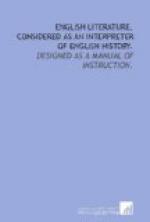Francis Quarles, 1592-1644: he was a Royalist, but belongs to the literary school of Withers. He is best known by his collection of moral and religious poems, called Divine Emblems, which were accompanied with quaint engraved illustrations. These allegories are full of unnatural conceits, and are many of them borrowed from an older source. He was immensely popular as a poet in his own day, and there was truth in the statement of Horace Walpole, that “Milton was forced to wait till the world had done admiring Quarles.”
George Herbert, 1593-1632: a man of birth and station, Herbert entered the Church, and as the incumbent of the living at Bemerton, he illustrated in his own piety and devotion “the beauty of holiness.” Conscientious and self-denying in his parish work, he found time to give forth those devout breathings which in harmony of expression, fervor of piety, and simplicity of thought, have been a goodly heritage to the Church ever since, while they still retain some of those “poetical surprises” which mark the literary taste of the age. His principal work is The Temple, or, Sacred Poems and Private Ejaculations. The short lyrics which form the stones of this temple are upon the rites and ceremonies of the Church and other sacred subjects: many of them are still in great favor, and will always be. In his portraiture of the Good Parson, he paints himself. He magnifies the office, and he fulfilled all the requirements he has laid down.
Robert Herrick, 1591-1674: like Herbert, Herrick was a clergyman, but, unlike Herbert, he was not a holy man. He wrote Anacreontic poems, full of wine and love, and appears to us like a reveller masking in a surplice. Being a cavalier in sentiment, he was ejected from his vicarage in 1648, and went to London, where he assumed the lay habit. In 1647 he published Hesperides, a collection of small poems of great lyric beauty, Anacreontic, pastoral, and amatory, but containing much that is coarse and indelicate. In 1648 he in part atoned for these by publishing his Noble Numbers, a collection of pious pieces, in the beginning of which he asks God’s forgiveness for his “unbaptized rhymes,” “writ in my wild, unhallowed times.” The best comment upon his works may be found in the words of a reviewer: “Herrick trifled in this way solely in compliment to the age; whenever he wrote to please himself, he wrote from the heart to the heart.” His Litanie is a noble and beautiful penitential petition.
Sir John Suckling, 1609-1641: a writer of love songs. That by which he is most favorably known is his exquisite Ballad upon a Wedding. He was a man of versatile talents; an officer in the army of Gustavus Adolphus, and a captain of horse in the army of Charles I. He wrote several plays, of which the best are Aglaura and The Discontented Colonel. While evidently tinctured by the spirit of the age, he exceeded his contemporaries in the purity of his style and manliness of his expression. His wit is not so forced as theirs.




